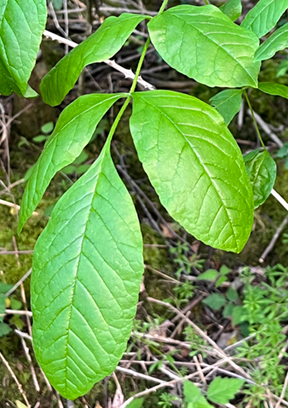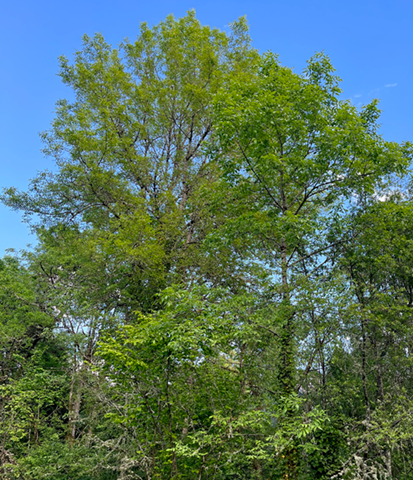Ash trees cool the water for fish


By Susan Mates, Treekeepers of Washington County
Ash trees provide more than just wood for baseball bats. Oregon ash trees (Fraxinus latifolia) are particularly suited to soggy soils and give back by shading streams for fish. Although not fussy about it, they are often found near streams or in swamps and flood plains. It is often too wet in these places for any other trees, even cottonwoods. But Oregon ash trees can adapt to flood conditions by increasing oxygen pathways down to their extensive roots. That dense root system keeps them standing in winds and water that topple most other species of trees.
An Oregon ash is our only native tree with compound leaves, and one of the few that has opposite branches. Each leaf is composed of five to seven leaflets that turn bright yellow in the fall. The bark of older ash trees has a distinctive diamond pattern of ridges, and they often have several trunks. Most of their branches and twigs are very straight. In winter you can identify ash trees by their dark, velvety deer hoof-shaped buds that are perched on top of a horseshoe-shaped leaf scar.

Ash trees are dioecious, meaning they grow as separate male and female trees. You will find tiny green blossoms without petals on the females in April or May, and yellow flowers on the males. The fruit, produced by female trees that are 30 years or older, is a cluster of samaras with wings like half of a maple seed. Each one is shaped like a little canoe with the small seed located near one end. Together they form large, drooping clusters that become brown and papery as they mature. When the wind carries them off in the fall, they spin like helicopters, traveling far from the mother.
These seeds are favorite foods for songbirds, squirrels, waterfowl and an occasional mouse. Swallowtails and other butterfly larvae consider their leaves a delicacy. Deer and elk browse on Oregon ash seedlings and the sprouts that grow from their stumps. Forests of Oregon ash form ribbons of trees along streams and sloughs. That creates important forest habitat in valleys that are otherwise cultivated farms or pastures, providing food and shelter for beavers.
When they grow in the open, the Oregon ash develops a broad crown, almost as wide as a Bigleaf maple (Acer macrophyllum). They grow quickly for the first 80 years then more slowly, living as long as 250 years. Their symmetry, speed of growth, and durable structure make then popular in yards and as city street trees. But it is at the water’s edge where they really shine. Their leaf canopy cools water for fish habitat and their fallen seeds provide valuable food for frogs and tadpoles. When we work to keep our rivers clean from pollution, the Oregon ash can support the unique wildlife that can only be found in its neighboring wetlands.
Protecting mature trees is the mission of. Contact us at treekeeperswc@gmail.com or visit our website to find out more.





